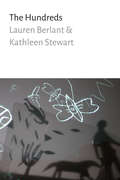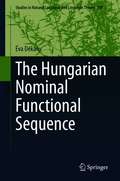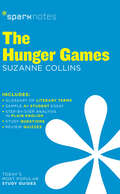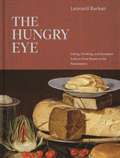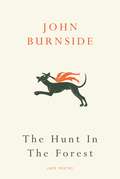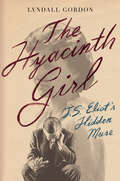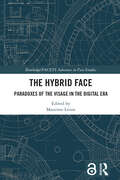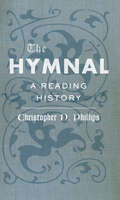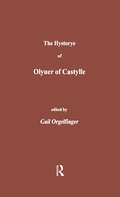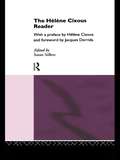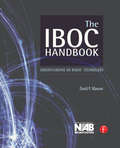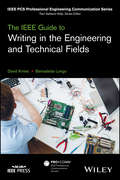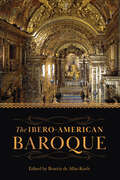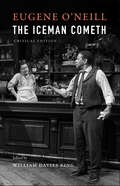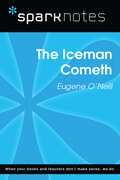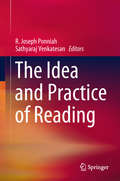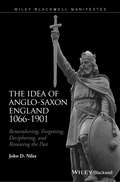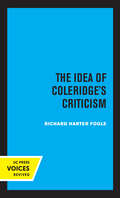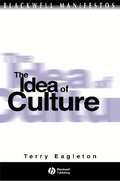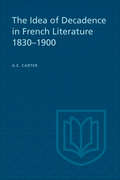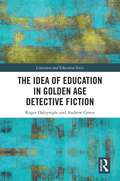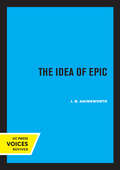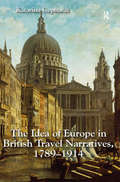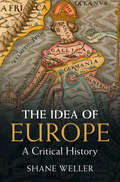- Table View
- List View
The Hundreds
by Kathleen Stewart Lauren BerlantIn The Hundreds Lauren Berlant and Kathleen Stewart speculate on writing, affect, politics, and attention to processes of world-making. The experiment of the one hundred word constraint—each piece is one hundred or multiples of one hundred words long—amplifies the resonance of things that are happening in atmospheres, rhythms of encounter, and scenes that shift the social and conceptual ground. What's an encounter with anything once it's seen as an incitement to composition? What's a concept or a theory if they're no longer seen as a truth effect, but a training in absorption, attention, and framing? The Hundreds includes four indexes in which Andrew Causey, Susan Lepselter, Fred Moten, and Stephen Muecke each respond with their own compositional, conceptual, and formal staging of the worlds of the book.
The Hungarian Nominal Functional Sequence (Studies in Natural Language and Linguistic Theory #100)
by Éva DékányThe Hungarian Nominal Functional Sequence combines the methods of syntactic cartography with evidence from compositional semantics in a comprehensive exploration of the structure of Noun Phrases. Proceeding from the lexical core to the top of DP, it uses Hungarian as a window on the underlying universal functional hierarchy of Noun Phrases, but it also regularly complements and supports the analysis with cross-linguistic evidence. The book works out a minimal map of the extended NP in the sense that the proposed hierarchy only has projections which host overt material and it does not draw on semantically empty word order projections. Topics which receive special attention include the syntax of classifiers, demonstratives, proper names, possessive NPs and plural pronouns.
The Hunger Games (SparkNotes Literature Guide Series #34)
by SparkNotesThe Hunger Games (SparkNotes Literature Guide) by Suzanne Collins Making the reading experience fun! When a paper is due, and dreaded exams loom, here's the lit-crit help students need to succeed! SparkNotes Literature Guides make studying smarter, better, and faster. They provide chapter-by-chapter analysis; explanations of key themes, motifs, and symbols; a review quiz; and essay topics. Lively and accessible, SparkNotes is perfect for late-night studying and paper writing. Includes:An A+ Essay—an actual literary essay written about the Spark-ed book—to show students how a paper should be written.16 pages devoted to writing a literary essay including: a glossary of literary termsStep-by-step tutoring on how to write a literary essayA feature on how not to plagiarize
The Hungry Eye: Eating, Drinking, and European Culture from Rome to the Renaissance
by Leonard BarkanAn enticing history of food and drink in Western art and cultureEating and drinking can be aesthetic experiences as well as sensory ones. The Hungry Eye takes readers from antiquity to the Renaissance to explore the central role of food and drink in literature, art, philosophy, religion, and statecraft.In this beautifully illustrated book, Leonard Barkan provides an illuminating meditation on how culture finds expression in what we eat and drink. Plato's Symposium is a timeless philosophical text, one that also describes a drinking party. Salome performed her dance at a banquet where the head of John the Baptist was presented on a platter. Barkan looks at ancient mosaics, Dutch still life, and Venetian Last Suppers. He describes how ancient Rome was a paradise of culinary obsessives, and explains what it meant for the Israelites to dine on manna. He discusses the surprising relationship between Renaissance perspective and dinner parties, and sheds new light on the moment when the risen Christ appears to his disciples hungry for a piece of broiled fish. Readers will browse the pages of the Deipnosophistae—an ancient Greek work in sixteen volumes about a single meal, complete with menus—and gain epicurean insights into such figures as Rabelais and Shakespeare, Leonardo and Vermeer.A book for anyone who relishes the pleasures of the table, The Hungry Eye is an erudite and uniquely personal look at all the glorious ways that food and drink have transfigured Western arts and high culture.
The Hunt in the Forest
by John BurnsideTaking its title from Uccello's famous painting of a band of men - on foot and on horseback - massing for the chase, John Burnside's new poems take us on a journey out of the light and into the darkness, where we may just as easily lose ourselves as find what we are looking for. In these poems of hunting and predation, Burnside explores our most deep-rooted and primeval pursuits: romantic love, memory, selfhood, grief, the recollection of the dead. Yet just as we seek, so are we sought out: at any moment we may slide into loss or be gathered in by some otherworldly light; at any moment, the angel of the annunciation may seek us out and demand some astonishing transformation. Even in the pursuit of love, or in the exercise of memory, we fall into snares and become entangled in veils; just as we are always on the point of discovery, so we are always a hair's-breadth away from being lost. Concerned with love and mourning, with what we discover and what remains hidden - with learning how to follow the trail through the forest and find the way home - above all, these poems are about the quest: knowing that whatever we bring back from the hunt, it is always hard-won and never fully our own.With this extraordinary collection of fleet and deftly beautiful poems, John Burnside confirms his place at the forefront of writing, as one of a handful of truly important British poets working today.
The Hyacinth Girl: T. S. Eliot's Hidden Muse
by Lyndall Gordon“Superb… brims with insight into T.S. Eliot’s complex love of women and its impact on his poetry. Beautifully written, fiercely honest, The Hyacinth Girl permanently dissolves the myth of impersonality, fathoming the vexed, tormented emotional life behind Eliot’s work.” —Jahan Ramazani, author of Poetry in a Global Age Winner of the Nobel Prize in Literature, T.S. Eliot was considered the greatest English-language poet of his generation. His poems The Waste Land and Four Quartets are classics of the modernist canon, while his essays influenced a school of literary criticism. Raised in St. Louis, shaped by his youth in Boston, he reinvented himself as an Englishman after converting to the Anglican Church. Like the authoritative yet restrained voice in his prose, he was the epitome of reserve. But there was another side to Eliot, as acclaimed biographer Lyndall Gordon reveals in her new biography, The Hyacinth Girl. While married twice, Eliot had an almost lifelong love for Emily Hale, an American drama teacher to whom he wrote extensive, illuminating, deeply personal letters. She was the source of “memory and desire” in The Waste Land. She was his hidden muse. That correspondence—some 1,131 letters—released by Princeton University’s Firestone Library only in 2020—shows us in exquisite detail the hidden Eliot. Gordon plumbs the archive to recast Hale’s role as the first and foremost woman of the poet’s life, tracing the ways in which their ardor and his idealization of her figured in his art. For Eliot’s relationships, as Gordon explains, were inextricable from his poetry, and Emily Hale was not the sole woman who entered his work. Gordon sheds new light on Eliot’s first marriage to the flamboyant Vivienne; re-creates his relationship with Mary Trevelyan, a wartime woman of action; and finally, explores his marriage to the young Valerie Fletcher, whose devotion to Eliot and whose physical ease transformed him into a man “made for love.” This stunning portrait of Eliot will compel not only a reassessment of the man—judgmental, duplicitous, intensely conflicted, and indubitably brilliant—but of the role of the choice women in his life and his writings. And at the center was Emily Hale in a love drama that Eliot conceived and the inspiration for the poetry he wrote that would last beyond their time. She was his “Hyacinth Girl."
The Hybrid Face: Paradoxes of the Visage in the Digital Era (Routledge/FACETS Advances in Face Studies)
by Massimo LeoneThis original and interdisciplinary volume explores the contemporary semiotic dimensions of the face from both scientific and sociocultural perspectives, putting forward several traditions, aspects, and signs of the human utopia of creating a hybrid face. The book semiotically delves into the multifaceted realm of the digital face, exploring its biological and social functions, the concept of masks, the impact of COVID-19, AI systems, digital portraiture, symbolic faces in films, viral communication, alien depictions, personhood in video games, online intimacy, and digital memorials. The human face is increasingly living a life that is not only that of the biological body but also that of its digital avatar, spread through a myriad of new channels and transformable through filters, post-productions, digital cosmetics, all the way to the creation of deepfakes. The digital face expresses new and largely unknown meanings, which this book explores and analyzes through an interdisciplinary but systematic approach. The volume will interest researchers, scholars, and advanced students who are interested in digital humanities, communication studies, semiotics, visual studies, visual anthropology, cultural studies, and, broadly speaking, innovative approaches about the meaning of the face in present-day digital societies.
The Hymnal: A Reading History
by Christopher N. PhillipsUnderstanding the culture of living with hymnbooks offers new insight into the histories of poetry, literacy, and religious devotion.It stands barely three inches high, a small brick of a book. The pages are skewed a bit, and evidence of a small handprint remains on the worn, cheap leather covers that don’t quite close. The book bears the marks of considerable use. But why—and for whom—was it made? Christopher N. Phillips’s The Hymnal is the first study to reconstruct the practices of reading and using hymnals, which were virtually everywhere in the eighteenth and nineteenth centuries. Isaac Watts invented a small, words-only hymnal at the dawn of the eighteenth century. For the next two hundred years, such hymnals were their owners’ constant companions at home, school, church, and in between. They were children's first books, slaves’ treasured heirlooms, and sources of devotional reading for much of the English-speaking world. Hymnals helped many people learn to memorize poetry and to read; they provided space to record family memories, pass notes in church, and carry everything from railroad tickets to holy cards to business letters. In communities as diverse as African Methodists, Reform Jews, Presbyterians, Methodists, Roman Catholics, and Unitarians, hymnals were integral to religious and literate life. An extended historical treatment of the hymn as a read text and media form, rather than a source used solely for singing, this book traces the lives people lived with hymnals, from obscure schoolchildren to Emily Dickinson. Readers will discover a wealth of connections between reading, education, poetry, and religion in Phillips’s lively accounts of hymnals and their readers.
The Hystorye of Olyuer of Castylle (Medieval Texts Series #No. 14)
by Gail OrgelfingerIn 1518, Wynkyn de Worde, Caxton’s successor as book publisher in London, issued a translation by Henry Watson of the Franco-Burgundian romance L'Istoire d'olivier de castille. The romance had already enjoyed great popularity on the Continent, having been printed first in French in 1482, in Spanish in 1499, in Flemish c. 1510 and in German in 1521.^ An Italian edition would follow in 1552. And another English version, this time translated from the Italian, appeared in 1695. Here an English translated version.
The Hélène Cixous Reader
by Susan SellersThis is the first truly representative collection of texts by Helene Cixous. The substantial pieces range broadly across her entire oeuvre, and include essays, works of fiction, lectures and drama. Arranged helpfully in chronological order, the extracts span twenty years of intellectual thought and demonstrate clearly the development of one of the most creative and brilliant minds of the twentieth century.With a foreword by Jacques Derrida, a preface by Cixous herself, and first-class editorial material by Susan Sellers, The Helene Cixous Reader is destined to become a key text of feminist writing.
The IBOC Handbook: Understanding HD Radio (TM) Technology
by David P. MaxsonRadio broadcast engineers seeking to design and operate HD Radio(TM) transmission systems will benefit from the detailed exposition of the technology. The book lays out the entire structure of this digital transmission system. System equations are presented in a manner that is useful to those interested in them, while retaining a clear narrative for those who seek a general understanding of how the technology works. The book also presents a summary of the history of the technology and the NRSC-5 standard, as well as forward-looking information on emerging technologies and applications.
The IEEE Guide to Writing in the Engineering and Technical Fields
by David Kmiec Bernadette LongoHelps both engineers and students improve their writing skills by learning to analyze target audience, tone, and purpose in order to effectively write technical documents This book introduces students and practicing engineers to all the components of writing in the workplace. It teaches readers how considerations of audience and purpose govern the structure of their documents within particular work settings. The IEEE Guide to Writing in the Engineering and Technical Fields is broken up into two sections: “Writing in Engineering Organizations” and “What Can You Do With Writing?” The first section helps readers approach their writing in a logical and persuasive way as well as analyze their purpose for writing. The second section demonstrates how to distinguish rhetorical situations and the generic forms to inform, train, persuade, and collaborate. The emergence of the global workplace has brought with it an increasingly important role for effective technical communication. Engineers more often need to work in cross-functional teams with people in different disciplines, in different countries, and in different parts of the world. Engineers must know how to communication in a rapidly evolving global environment, as both practitioners of global English and developers of technical documents. Effective communication is critical in these settings. The IEEE Guide to Writing in the Engineering and Technical Fields Addresses the increasing demand for technical writing courses geared toward engineers Allows readers to perfect their writing skills in order to present knowledge and ideas to clients, government, and general public Covers topics most important to the working engineer, and includes sample documents Includes a companion website that offers engineering documents based on real projects The IEEE Guide to Engineering Communication is a handbook developed specifically for engineers and engineering students. Using an argumentation framework, the handbook presents information about forms of engineering communication in a clear and accessible format. This book introduces both forms that are characteristic of the engineering workplace and principles of logic and rhetoric that underlie these forms. As a result, students and practicing engineers can improve their writing in any situation they encounter, because they can use these principles to analyze audience, purpose, tone, and form.
The Ibero-American Baroque (Toronto Iberic)
by Beatriz de Alba-KochThe Baroque was the first truly global culture. The Ibero-American Baroque illuminates its dissemination, dynamism, and transformation during the early modern period on both sides of the Atlantic. This collection of original essays focuses on the media, institutions, and technologies that were central to cultural exchanges in a broad early modern Iberian world, brought into being in the aftermath of the Spanish and Portuguese arrivals in the Americas. Focusing on the period from 1600 to 1825, these essays explore early modern Iberian architecture, painting, sculpture, music, sermons, reliquaries, processions, emblems, and dreams, shedding light on the Baroque as a historical moment of far-reaching and long-lasting importance. Anchored in extensive, empirical research that provides evidence for understanding how the Baroque became globalized, The Ibero-American Baroque showcases the ways in which the Baroque has continued to define Latin American identities in the twentieth and twenty-first centuries.
The Iceman Cometh
by Eugene O'NeillA critical edition of O&’Neill&’s most complex and difficult play, designed for student readers and performers This critical edition of Eugene O&’Neill&’s most complex and difficult play helps students and performers meet the work&’s demanding cultural literacy. William Davies King provides an invaluable guide to the text, including an essay on historical and critical perspectives; extensive notes on the language used in the play, and its many musical and literary allusions; as well as numerous insightful illustrations. He also gives biographical details about the actual people the characters are based on, along with the performance history of the play, to help students and theatrical artists engage with this labyrinthine work.
The Iceman Cometh (SparkNotes Literature Guide Series)
by SparkNotesThe Iceman Cometh (SparkNotes Literature Guide) by Eugene O'Neill Making the reading experience fun! Created by Harvard students for students everywhere, SparkNotes is a new breed of study guide: smarter, better, faster. Geared to what today's students need to know, SparkNotes provides: *Chapter-by-chapter analysis *Explanations of key themes, motifs, and symbols *A review quiz and essay topicsLively and accessible, these guides are perfect for late-night studying and writing papers
The Icky Bug Alphabet Book (Jerry Pallotta's Alphabet Books)
by Jerry PallottaLearn your ABCs in this &“icky&” exploration of all the creepy crawly insects from A to Z. Best-selling author Jerry Pallotta delivers a fun first concepts book that helps children discover why farmers like pray mantis, why fireflies light up the sky, or how water spiders breathe underwater. Pallotta&’s signature witty yet scientific text paired with Masiello&’s vivid and detailed illustrations make this alphabetic exploration one that will keep curious readers intrigued and engaged as they learn about the natural world of bugs.
The Idea and Practice of Reading
by R. Joseph Ponniah Sathyaraj VenkatesanThis book addresses basic issues in language education and explores how reading, with a focus on meaning, contributes to the development of all aspects of language including vocabulary, spelling, grammar, and syntax. It departs from traditional methods and practices in language learning to investigate the potency of reading in improving language acquisition. The traditional practice in language classes to teach language skills explicitly through acquiring forms and structures of language is often less than successful, and teachers are gradually incorporating reading materials and practices into the curriculum. This book provides important inputs to language teachers and educators on the need to include reading as an idea and as a practice into the curriculum. Among other things, it explores the benefits of incidental learning of language properties such as vocabulary, syntax and grammar and gives adequate exposure to different types of reading strategies to promote reading among learners. It also exploits the possible transfer of L1 reading strategies and capabilities to L2 reading for language acquisition. In so doing, this book hopes to promote autonomous learning among L2 learners and guide readers in alternative strategies to solve comprehension problems.
The Idea of Anglo-Saxon England 1066-1901: Remembering, Forgetting, Deciphering, and Renewing the Past
by John D. NilesThe Idea of Anglo Saxon England, 1066-1901 presents the first systematic review of the ways in which Anglo-Saxon studies have evolved from their beginnings to the twentieth century Tells the story of how the idea of Anglo-Saxon England evolved from the Anglo-Saxons themselves to the Victorians, serving as a myth of origins for the English people, their language, and some of their most cherished institutions Combines original research with established scholarship to reveal how current conceptions of English identity might be very different if it were not for the discovery – and invention – of the Anglo-Saxon past Reveals how documents dating from the Anglo-Saxon era have greatly influenced modern attitudes toward nationhood, race, religious practice, and constitutional liberties Includes more than fifty images of manuscripts, early printed books, paintings, sculptures, and major historians of the era
The Idea of Coleridge's Criticism: Perspectives in Criticism (Perspectives in Criticism #9)
by Richard Harter FogleThis title is part of UC Press's Voices Revived program, which commemorates University of California Press’s mission to seek out and cultivate the brightest minds and give them voice, reach, and impact. Drawing on a backlist dating to 1893, Voices Revived makes high-quality, peer-reviewed scholarship accessible once again using print-on-demand technology. This title was originally published in 1962.
The Idea of Culture (Wiley-Blackwell Manifestos #19)
by Terry EagletonTerry Eagleton's book, in this vital new series from Blackwell, focuses on discriminating different meanings of culture, as a way of introducing to the general reader the contemporary debates around it.
The Idea of Decadence in French Literature, 1830-1900 (University of Toronto Romance Series #3)
by A. E. CarterThe cult of decadence is usually dismissed as an eccentricity of French literature, a final twitter of Romantic neurosis, convulsing the lunatic fringe of letters during the last third of the nineteenth century. However, the nineteenth century's preoccupation with decadence provides us with a key to the secret places of its thought, to all the obscure passages and backstairs behind the triumphant façade. Between 1814 and 1914, there was no sense of disaster, no tragic sense. Civilization had become a habit, a side product of political constitutions and applied science. History was viewed pragmatically: of what use were such traditional symbols as throne and altar? Both are essentially propitiatory, evidence of man's uneasy knowledge that power is dangerous and destiny implacable. And both seemed anachronisms in a world where (it was thought) human reason had solved or would solve all the old problems. The theory of decadence is very largely a protest against this comfortable belief. Had the decadents not written, we should hardly suspect that the nineteenth century suffered from the same doubts and hesitations as all other ages, before and since.
The Idea of Education in Golden Age Detective Fiction (Literature and Education)
by Andrew Green Roger DalrympleThis book presents an exploration of how Golden Age detective fiction encounters educational ideas, particularly those forged by the transformative educational policymaking of the interwar period.Charting the educational policy and provision of the era, and referring to works by Agatha Christie, Dorothy L. Sayers, Edmund Crispin and others, this book explores the educational capacity and agency of literary detectives, the learning spaces of the genre and the kinds of knowledge that are made available to inquirers both inside and outside the text. It is argued that the genre explores a range of contemporaneous propositions on the balance between academic curriculum and practicum, length of school life and the value of lifelong learning. This book’s closing chapter considers the continuing pedagogic value for contemporary classrooms of engaging with the genre as a rich discursive and imaginative space for exploring educational ideas.Framing Golden Age detective fiction as a genre profoundly concerned with learning, this book will be highly relevant reading for academics, postgraduate students and scholars involved in the fields of English language arts, twentieth-century literature and the theories of learning more broadly. Those interested in detective fiction and interdisciplinary literary studies will also find the volume of interest.
The Idea of Epic (EIDOS: Studies in Classical Kinds #3)
by J. B. HainsworthThis title is part of UC Press's Voices Revived program, which commemorates University of California Press’s mission to seek out and cultivate the brightest minds and give them voice, reach, and impact. Drawing on a backlist dating to 1893, Voices Revived makes high-quality, peer-reviewed scholarship accessible once again using print-on-demand technology. This title was originally published in 1991.
The Idea of Europe in British Travel Narratives, 1789-1914
by Katarina GephardtThe nineteenth century was the heyday of travel, with Britons continually reassessing their own culture in relation to not only the colonized but also other Europeans, especially the ones that they encountered on the southern and eastern peripheries of the continent. Offering illustrative case studies, Katarina Gephardt shows how specific rhetorical strategies used in contemporary travel writing produced popular fictional representations of continental Europe in the works of Ann Radcliffe, Lord Byron, Charles Dickens, and Bram Stoker. She examines a wide range of autobiographical and fictional travel narratives to demonstrate that the imaginative geographies underpinning British ideas of Europe emerged from the spaces between fact and fiction. Adding texture to her study are her analyses of the visual dimensions of cross-cultural representation and of the role of evolving technologies in defining a shared set of rhetorical strategies. Gephardt argues that British writers envisioned their country simultaneously as distinct from the Continent and as a part of Europe, anticipating the contradictory British discourse around European integration that involves both fear that the European super-state will violate British sovereignty and a desire to play a more central role in the European Union.
The Idea of Europe: A Critical History
by Shane WellerThere is an increasingly widespread sense that Europe is in crisis. Notions of a shared European identity and a common European culture appear to be losing their purchase. This crisis is often seen as a conflict between a cosmopolitan and a nationalist idea of Europe. The reality is, however, considerably more complex, as the long history of the idea of Europe reveals. In The Idea of Europe: A Critical History, Shane Weller explores that history from its origins in classical antiquity to the present day. Drawing on a wide range of sources, he demonstrates that, all too often, seemingly progressive ideas of Europe have been shaped by Eurocentric, culturally supremacist, and even racist assumptions. Seeking to break with this troubling pattern, Weller calls for an idea of Europe shaped by a spirit of self-critique and by an openness to those cultures that have for so long been dismissed as non-European.
